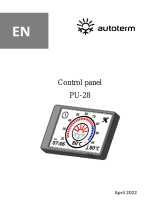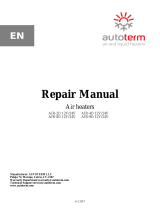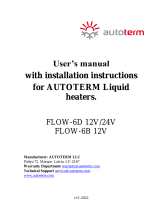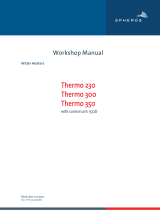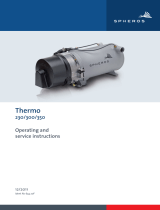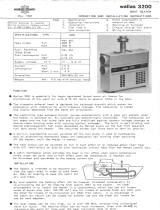Page is loading ...

Water Heaters
09/2001
Workshop Manual
Thermo 90
Thermo 90-TRS
(Transport of hazardous goods)
Thermo 90 S
Thermo 90 S-TRS
(Transport of hazardous goods)
Type BW 80 (Fuel)
Type DW 80 (Diesel)

Thermo 90 List of Contents
I
List of Contents
1 Introduction
1.1 Scope and Purpose............................................................................................................................... 101
1.2 Meaning of Warnings, Cautions, and Notes.......................................................................................... 101
1.3 Additional Documentation to be used.................................................................................................... 101
1.4 Safety Information and Regulations....................................................................................................... 101
1.4.1 General Safety Notes.................................................................................................................. 101
1.5 Legal Provisions for Installation............................................................................................................. 102
1.6 Corrections and Improvements.............................................................................................................. 103
2 General Description
2.1 Combustion Air Fan............................................................................................................................... 202
2.2 Heat Exchanger..................................................................................................................................... 202
2.3 Temperature Sensor.............................................................................................................................. 203
2.4 Temperature Limiter .............................................................................................................................. 203
2.5 Burner Insert.......................................................................................................................................... 203
2.6 Glow Plug .............................................................................................................................................. 203
2.7 Flame Sensor ........................................................................................................................................ 203
2.8 Combustion Tube .................................................................................................................................. 203
2.9 Circulation Pump ................................................................................................................................... 203
2.10 Control Unit............................................................................................................................................ 203
2.11 Dosing Pump......................................................................................................................................... 203
3 Troubleshooting
3.1 Switch-on............................................................................................................................................... 301
3.2 Heating Operation.................................................................................................................................. 301
3.3 Control Operation .................................................................................................................................. 301
3.4 Switch-off............................................................................................................................................... 301
3.5 Functions of the Heater in TRS Vehicles............................................................................................... 301
3.6 Malfunctions........................................................................................................................................... 303
3.6.1 Switch-off upon Failure................................................................................................................ 303
3.6.2 Diagnosis after Switch-off upon Failure (Thermo 90).................................................................. 303
3.6.3 Diagnosis after Switch-off upon Failure (Thermo 90 S)............................................................... 303
4 Technical Data................................................................................................................................................ 401
5 Troubleshooting
5.1 General.................................................................................................................................................. 501
5.2 General Failure Symptoms.................................................................................................................... 501
5.3 Failure Symptoms after Switch-off upon Failure.................................................................................... 502
5.4 Visual Inspection for Assessment of Burner Condition.......................................................................... 503
5.4.1 Burner Housing............................................................................................................................ 503
5.4.2 Rear Wall with Metal Evaporator................................................................................................. 504
5.4.3 Combustion Chamber.................................................................................................................. 504
5.4.4 Burner Assembly......................................................................................................................... 504

List of Contents Thermo 90
II
6 Functional Tests
6.1 General................................................................................................................................................. 601
6.2 Adjustments.......................................................................................................................................... 601
6.2.1 Adjustment of the CO2 Contents ................................................................................................ 601
6.3 Components Testing............................................................................................................................. 601
6.3.1 Temperature Sensor Resistance Check..................................................................................... 601
6.3.2 Glow Plug Resistance Test......................................................................................................... 601
6.3.3 Flame Sensor Resistance Test................................................................................................... 601
6.3.4 Combustion Air Fan Test............................................................................................................ 601
7 Circuit Diagrams
7.1 General................................................................................................................................................. 701
8 Servicing
8.1 General................................................................................................................................................. 801
8.2 Work on the Heater............................................................................................................................... 801
8.3 Work on the Vehicle.............................................................................................................................. 801
8.4 Heater Test Run.................................................................................................................................... 801
8.5 Servicing............................................................................................................................................... 801
8.6 Visual Inspections and Installation Regulations.................................................................................... 803
8.6.1 Connection to the Vehicle's Cooling System.............................................................................. 803
8.6.2 Connection to the Vehicle's Fuel System................................................................................... 803
8.6.3 Dosing Pump.............................................................................................................................. 805
8.6.4 Fuel Filter.................................................................................................................................... 806
8.6.5 Combustion Air Supply............................................................................................................... 806
8.6.6 Exhaust Line............................................................................................................................... 806
8.7 Removal and Installation....................................................................................................................... 807
8.7.1 Heater, Removal and Installation................................................................................................ 807
8.7.2 Replacement of Circulation Pump.............................................................................................. 807
8.7.3 Replacement of Temperature Limiter......................................................................................... 807
8.7.4 Replacement of Temperature Sensor......................................................................................... 807
8.7.5 Replacement of Combustion Air Fan.......................................................................................... 807
8.8 First Operation...................................................................................................................................... 807

Thermo 90 List of Contents
III
9Repair
9.1 General.................................................................................................................................................. 901
9.1.1 Work on Components after Disassembly.................................................................................... 901
9.2 Disassembly and Assembly................................................................................................................... 902
9.2.1 Electrical Connections................................................................................................................. 902
9.2.2 Replacement of Circulation Pump............................................................................................... 903
9.2.3 Replacement of Temperature Limiter.......................................................................................... 904
9.2.4 Replacement of Temperature Sensor ......................................................................................... 904
9.2.5 Replacement of Combustion Air Fan........................................................................................... 906
9.2.6 Replacement of Burner, Flame Sensor, and Glow Plug.............................................................. 907
9.2.7 Replacement of Burner Head...................................................................................................... 909
9.2.8 Replacement of Heat Exchanger................................................................................................. 910
10 Packaging/Storage and Shipping
10.1 General................................................................................................................................................ 1001

List of Figures Thermo 90
IV
List of Figures
301 Functional Sequence................................................................................................................................. 302
501 General Failure Symptoms........................................................................................................................ 501
502 Failure Symptoms after Switch-off upon Failure........................................................................................ 502
503 Visual Inspection, Burner Real Wall........................................................................................................... 503
504 Visual Inspection, Pilot Flame Exit Bore .................................................................................................... 504
505 Visual Inspection, Burner Assembly .......................................................................................................... 504
701 Pin Assignment........................................................................................................................................... 701
702 Circuit Diagram Automatic Control for Thermo 90, 12 and 24 V with Triple Timer .................................... 702
703 Circuit Diagram Automatic Control Thermo 90-TRS, 24 V ........................................................................ 703
704 Circuit Diagram Automatic Control for Thermo 90 S, 12 and 24 V with Standard Timer........................... 704
705 Circuit Diagram Automatic Control for Thermo 90 S-TRS, 24 V................................................................ 705
706 Circuit Diagram Automatic Control for Thermo 90 S-TRS, 24 V without Auxiliary Drive ........................... 706
801 Example for Heater Installation in Lorry..................................................................................................... 802
802 Fuel Supply................................................................................................................................................ 803
803 Webasto Fuel Tank Tap............................................................................................................................. 804
804 Fuel Tapping from Plastic Tank (tapping via fuel drain plug)..................................................................... 804
805 Fuel Tapping from Plastic Tank (tapping via fitting plate).......................................................................... 804
806 Pipe/Hose Connection............................................................................................................................... 805
807 Dosing Pump, Installation Location and Attachment ................................................................................. 805
808 Exhaust Muffler, Direction of Flow ............................................................................................................. 806
901 Electrical Connections ............................................................................................................................... 902
902 Replacement of Circulation Pump ............................................................................................................. 903
903 Replacement of Temperature Limiter and Temperature Sensor ............................................................... 905
904 Replacement of Combustion Air Fan......................................................................................................... 906
905 Replacement of Burner, Flame Sensor, and Glow Plug............................................................................ 908
906 Replacement of Burner Head .................................................................................................................... 909

Thermo 90 1 Introduction
101
1Introduction
1.1 Scope and Purpose
This repair shop manual is intended to support
familiarised personnel in the repair of Thermo 90 and
Thermo 90 S for the Diesel and fuel type.
The water heater may only be operated with the specified
fuel (diesel or also fuel oil EL) and the relevant designated
type of electrical connection.
1.2 Meaning of Warnings, Cautions,
and Notes
WARNINGS, CAUTIONS, and NOTES in this manual
have the following meaning:
WARNING
This heading is used to highlight that non-compliance
with instructions or procedures may cause injuries or
lethal accidents to personnel.
CAUTION
This heading is used to highlight that non-compliance
with instructions or procedures may cause damage to
equipment.
NOTE
This heading is used to highlight and draw specific
attention to information.
1.3 Additional Documentation
to be used
This workshop manual contains all information and
procedures necessary for the repair of heaters Thermo 90
and Thermo 90 S.
The use of additional documentation is normally not
necessary.
Operating instructions/installation instructions and the
vehicle specific installation proposal may be used as
complementary information as necessary.
1.4 Safety Information and Regulations
The general safety regulations for the prevention of
accidents and the relevant operating safety instructions
have to be observed at all times.
"General Safety Regulations" beyond the scope of these
regulations are detailed in the following.
The specific safety regulations applicable to this manual
are highlighted in the individual chapters by Warnings,
Cautions, and Notes.
1.4.1 General Safety Notes
Within the scope of the StVZO (Road Licensing
Regulations of the Federal Republic of Germany)
"Design General Approvals", laid down by the Federal-
Office for Motor Traffic, exist for the Water Heater
Thermo 90 with the following official marks of conformity:
~S231 for water heater Thermo 90 and
Thermo 90 S Fuel Type BW 80
~S232 for water heater Thermo 90 and
Thermo 90 S Diesel Type DW 80 and
for water heater Thermo 90-TRS and
Thermo 90 S-TRS Diesel Type DW 80.
The installation of the heaters is to be performed in
accordance with the installation instructions and must be
checked in case of
a) the vehicle type inspection in accordance with
§ 20 StVZO
b) the individual inspection in accordance with
§ 21 StVZO or
c) the examination in accordance with § 19 StVZO
performed by an officially authorised expert or
examiner for road traffic, a vehicle inspector or a
public servant as per section 7.4a of Annex VIII to
the StVZO.
In the event of c) the installation must be certified
on the acceptance certificate included in the copy of the
"General Operating License" giving details about
–manufacturer
–type of vehicle and
–vehicle identification number.
This validates the "Design General Approval". The
acceptance certificate must be kept with the vehicle.
The year of first operation must be permanently
marked on the identification label by removing the
relevant number of the year.
The heaters are cleared for heating the passenger and
driver cabins but not for heating compartments used for
the transportation of dangerous goods.
The use of the heater in special vehicles (e.g. vehicles for
the transportation of dangerous goods TRS) or vehicles
not subject to the StVZO (e.g. ships) is partly governed by
regional regulations.

1 Introduction
102
For the installation of the Thermo 90-TRS or
Thermo 90 S-TRS in vehicles used for the transportation
of dangerous goods, in addition to the StVZO, the
requirements in TRS 002 and TRS 003 (Technical
Guidelines for the Transportation of Dangerous Goods on
Roads) must be met.
The heater may only be installed in motor vehicles or in
independent heating systems with a minimum coolant
capacity of 6 litres.
The heater must not be installed in the passenger or
driver compartments of vehicles. Should the heater
nevertheless be installed in such a compartment, the
installation box must be sealed tight against the vehicle
interior. There must be sufficient ventilation of the
installation box from the exterior in order not to exceed a
maximum temperature of 60° C in the installation box.
Excessive temperatures may cause malfunctions.
WARNING
Due to the danger of poisoning and suffocation, the
heater must not be operated in enclosed areas such
as garages or workshops without an exhaust venting
facility, not even if the start-up is activated by the
timer or telestart device.
At filling stations and fuel depots the heater must be
switched off as there is a potential danger of
explosion.
CAUTION
Where flammable fumes or dust may build up
(e.g. in the vicinity of fuel, coal, wood, cereal depots,
or similar installations) the heater must be switched
off to prevent explosions.
In the vicinity of the water heater a temperature of 85° C
must not be exceeded under any circumstances
(e.g. during body paint work).
A violation of this temperature limit may cause permanent
damage to the electronics.
When checking the cooling water level, proceed in
accordance with the vehicle manufacturer's instructions.
The water in the heating circuit of the heater must contain
a minimum of 10% of a quality brand anti-freeze.
Ignoring the installation instructions and its procedures
will void the warranty granted by Webasto. The same
applies for repairs performed by unskilled personnel and
repairs without using original spare parts. This will void the
water heater's "Official Marks of Conformity" and thus the
vehicle's permit of operation.
1.5 Legal Provisions for Installation
For testing the heater in accordance with § 19, 20, or 21
of the StVZO the following regulations are to be observed
in particular (§ 22 a StVZO):
Testing is performed upon presentation of the operating
and installation instructions of the manufacturer. The
year of the initial operation must be durably marked on
the heater identification plate by the installing person.
Extracting combustion air from the vehicle interior is not
permissible.
The exhaust line outlet is to be positioned at the top, at
the side, or in case of exhaust venting, below the vehicle
floor, to the nearest possible location of the vehicle's or
cockpit side or rear end. Exhaust pipes must be routed
so that exhaust fumes are unlikely to penetrate into the
vehicle's interior. The function of any parts vital for
vehicle operation must not be impaired. Condensation
accumulation in the exhaust line must be directly
drained. A condensation drain hole may be provided as
required.
In installations the openings of the combustion air inlet
and the exhaust outlet must not allow a ball of 16 mm in
diameter to be inserted.
Electrical lines, switch gear, and control gear of the
heater must be located in the vehicle so that their proper
function cannot be impaired under normal operating
conditions.
For the routing of fuel lines and the installation of
additional fuel tanks, §§ 45 and 46 of the StVZO are to be
adhered to. The most important regulations are:
•Fuel lines are to be designed in such a way that
they remain unaffected by torsional stresses in the
vehicle, engine movement, and the like. They must be
protected against mechanical damage. Fuel-carrying
parts are to be protected against excessive heat and
are to be arranged so that any dripping or evaporating
fuel can neither accumulate nor be ignited by hot
components or electrical equipment.
•In busses, fuel lines and fuel tanks must not be located
in the passenger area or in the driver's compartment.
In these type of vehicles the fuel tanks must be located
such that they do not pose a direct hazard to the exits
in the event of a fire. Fuel supply must not be by
means of gravity or pressurisation of the fuel tank.

Thermo 90 1 Introduction
103
•Installation Instructions for Webasto fuel tanks for the
fuel supply of water heaters in vehicles:
In busses the installation is not permitted in the
passengers or driver's compartment.
•The fuel filler neck must not be located in the
passengers or driver's compartment of any vehicle.
•Fuel containers for carburettor fuel must not be
located immediately behind the front panelling of the
vehicle. They must be separate from the engine so
that even in case of an accident the inflammation of
fuel is unlikely to be expected. This does not apply
for towing vehicles with an open cockpit.
All fuel containers offered in the Webasto
Accessories Catalogue are suitable for a maximum
operating pressure of 0.15 bar overpressure.
All fuel containers offered in the Webasto
Accessories Catalogue are subjected during
manufacture to individual pressure testing with at least
0.3 bar overpressure.
•The fuel containers must either be equipped with a
vent cap or be ventilated in another way (ventilation
line).
Only filler caps in accordance with DIN 73400 may be
used.
•The operational state of the heater, i.e. an indication
"on" or "off", must be easily and clearly visible.
1.6 Corrections and Improvements
Deficiencies, improvements, or proposals for correction of
this workshop manual are to be mailed to:
Webasto Thermosysteme International GmbH
Abt. Technische Dokumentation
D-82131 Stockdorf
Telefon: 0 89 / 8 57 94 - 5 42
Telefax: 0 89 / 8 57 94 - 7 57

1 Introduction
104
Page free for notes

Thermo 90 2 General Description
201
2 General Description
The water heater Webasto Thermo 90 and Thermo 90 S
in combination with the vehicle's own heating system is
used to:
–heat the cabin
–defrost the windshields
–preheat water-cooled engines.
The water heater operates independent from the vehicle
engine and is connected to the cooling system, the fuel
system, and the electrical system of the vehicle.
The heater, designed to the evaporator principle,
operates intermittently and is controlled by the
temperature sensor.
Dependent on the deviation of the current coolant
temperature from the rated value of the temperature
sensor, combustion performance is continuously
controlled within the range from 1.8 to 7.6 kW for Diesel
operated heaters and within 2.0 to 7.6 kW for fuel
operated water heaters. For an extremely high heating
performance requirement (preheating) the maximum
performance of 9.1 kW is available in case of Diesel
operated water heaters for up to 2 hours after equipment
activation.
The water heater Thermo 90 and Thermo 90 S basically
consists of:
–combustion air fan
–heat exchange
–burner insert with combustion tube
–circulation pump
For control and monitoring a
–control unit (external)
–flame sensor
–glow plug
–temperature sensor
–temperature limiter
are located inside the unit.
On the Thermo 90 S heater the control unit may also be
flanged to the combustion air fan.
Fuel supply is provided externally by a fuel dosing pump.
Heater Thermo 90
Thermo 90
1 Combustion Air Fan
2 Fuel Connection
3 Temperature Sensor
4 Temperature Limiter
5 Heat Exchanger
6 Inlet, Coolant
7 Circulation Pump
8 Outlet, Coolant
9 Outlet, Exhaust
10 Inlet, Combustion Air
1
2
3
4
5
6
7
8
9
10
NOTE
One of the newer models shown. Older
models have the cable of the temperature
sensor located on the side.

2 General Description Thermo 90
202
Heater Thermo 90 S
2.1 Combustion Air Fan
The combustion air fan delivers the air required for
combustion from the combustion air inlet to the burner
insert.
2.2 Heat Exchanger
The heat exchanger dissipates the heat provided by
combustion to the coolant circuit.
Heat Exchanger
Thermo 90 S
1
23
4
5
6
7
8
9
10
11
1 Combustion Air Fan
2 Fuel Connection
3 Temperature Sensor
4 Temperature Limiter
5 Heat Exchanger
6 Inlet, Coolant
7 Circulation Pump
8 Outlet, Coolant
9 Outlet, Exhaust
10 Inlet, Combustion Air
11 Control unit (may also
be located externally
in the vehicle)
Temperature Limiter
Temperature Sensor

Thermo 90 2 General Description
203
2.3 Temperature Sensor
The temperature sensor senses the coolant temperature
in the heat exchanger of the heater unit as electrical
resistance. This signal is fed to the control unit for
processing.
2.4 Temperature Limiter
The overheat protection (bimetal) protects the heater unit
from excessive operating temperatures. The overheat
protection responds at a coolant temperature higher than
105° C to switch off the heater.
2.5 Burner Insert
Within the burner insert fuel is distributed in the
combustion tube across the burner cross-section.
2.6 Glow Plug
The glow plug ignites the fuel/air mixture at the start of
heater operation. The glow plug is acting as an electrical
resistor and is located in the burner insert opposite to the
flame source.
2.7 Flame Sensor
The flame sensor is a low-Ohm PTC resistor, changing
its resistance dependent on its heating by the flame.
The signals are routed to the control unit for processing.
The flame sensor monitors the flame operating condition
over the complete duration of heater operation.
2.8 Combustion Tube
Inside the combustion tube the combustion of the fuel/air
mixture takes place, heating up the heat exchanger.
2.9 Circulation Pump
The circulation pump provides for circulation of the
coolant in the vehicle and heater circuits. The control unit
switches the pump on for operation throughout the entire
time of heater operation (also in control idle).
Circulation Pump
2.10 Control Unit
The control unit is the central controlling device for
functional sequencing and monitoring of the combustion
operation. It is located externally in the vehicle, but may
also be flanged to the combustion air fan on Thermo 90 S
heaters.
2.11 Dosing Pump
Fuel supply to the heater and its dosing is ensured
externally by a dosing pump. When the heater is
deactivated, it also serves as a shut-off facility.
The magnetic coil of the dosing pump receives the pulses
from the microprocessor of the control unit.
Burner Insert
Glow Plug
Flame Sensor

2 General Description Thermo 90
204
Page free for notes

Thermo 90 3 Functional Description
301
3 Functional Description
(Fig. 301)
3.1 Switch-on
When operating the push button "Immediate Heating",
the "Operating Indicator" on the timer illuminates
or
by activation with the switch, the operating indicator
integrated in the switch illuminates.
Circulation pump, glow plug, and combustion air fan are
put into operation.
3.2 Heating Operation
After approx. 50 seconds, combustion commences with
the automatically controlled heating operation in full load
for a maximum of 2 hours.
The vehicle's own heating blower starts to operate only
after the heat carrier (coolant) has accumulated enough
heat. After reaching the pre-coded rated temperature
(see table Control Temperatures) heating performance
precision control will take over in stages down to the
lowest part load operation.
3.3 Control Operation
If the coolant temperature rises up to the control idle
threshold, the heater enters the control idle phase.
The circulation pump, the vehicle's own blower, and the
operating indicator remain in operation during the control
idle period.
After the coolant has cooled down to the precoded
reactivation temperature, the heater resumes operation.
Diesel Operated Water heaters
If the water heater's water temperature is above the
rated temperature but has not yet reached the threshold
for control idle with the temperature dropping within
10 minutes back to rated temperature (after reaching it for
the first time), the water heater reverts to the 9.1 kW
heating stage. Should the rated temperature be obtained
after 10 minutes, there will be an automatic reactivation
only up to heating stage 7.6 kW.
Fuel Operated Water Heaters
The maximum heating performance of fuel operated
water heaters is always 7.6 kW.

3 Functional Description Thermo 90
302
3.4 Switch-off
When switching the heater off, the operation indicator
on the timer/switch extinguishes. Combustion ends and
run-down is initiated. Circulation pump and combustion air
fan, however, continue operation to cool down the heater
(run-down) and are automatically deactivated after about
90 seconds. A reactivation of the heater during run-down
is permitted.
Room temperature control by means of the vehicle's own
heating blower may be provided in addition to employing
a room thermostat.
3.5 Functions of the Heater in TRS
Vehicles
The heater is started using the switch. A TRS condition
(forced deactivation) will be released after
–the vehicle engine is turned off
–a conveyor facility is started
with the short run-down terminating after 20 seconds.
Then the control unit is in the "error lockout" mode. Prior
to reactivation the On/Off switch must be set to "Off".
The isolation switch (emergency off switch) must only be
operated in case of emergency, as the heater is switched
off without run-down (overheating possible).
Fig. 301 Functional Sequence
Functional Sequence for Thermo 90
Switch-on
Configuration Check
Preheating 40 sec. (cycled)
Dosing Pump Priming 5 - 7 sec. (1)
Dosing Pump / Part Load (1/4)
Flame Sensor Take-over
Stabilisation Time
Full Load
Vehicle Blower »On«
Control Range
Control Idle
Flame Sensor »cold« (0)
Run-down completed
Preheating 15 – 20 sec. (cycled)
Dosing Pump Priming 5 – 7 sec. (1)
Dosing Pump / Part Load (1/4)
Flame Sensor Take-over
Stabilisation Time
Coolant Temperature down
Full Load
Switch-off (run-down)
Flame Sensor "cold" (0)
Run-down completed
A Glow Plug
B Dosing Pump
C Combustion Air Fan
D Flame Sensor
E Operation Indicator Light
F Circulation Pump
A
B
C
D
E
F
G
1
0
1
0
0
0
0
0
0
1
1
1
1
1
1/4
1/2
1/4
*
30 80 90 75 70 °C
2
3
22
212019171614131110
181512
986431
2 5 7
Sicherheitszeit
❏
*In case of a no-flame-
condition automatic restart
is initiated (20 sec. cycled
preheating, 90 sec. safety
time)
oPossible codeable control
temperatures, see table
below
1
2
3
4
5
6
7
8
9
10
11
12
13
14
15
16
17
18
19
20
21
22
23

Thermo 90 3 Functional Description
303
G Vehicle Blower
Setting of Control Temperatures Thermo 90
On the standard wiring harness B6 is not in use.
NOTE
The selected control idle temperature of the heater
should be below the opening temperature of the cooler
thermostat!
Setting of Control Temperatures Thermo 90 S
Connection of signal "motor on"/ "motor off" (terminal D+)
to the control unit (connector X12, contact 7) will enable
different thereshold values.
If the signal terminal D+ is not connected, temperatures
will be those linke for "motor off".
NOTE
The selected control idle temperature of the heater
should be below the opening temperature of the cooler
thermostat!
3.6 Malfunctions
3.6.1 Switch-off upon Failure
In case of a no-flame condition fuel is delivered for a
max. of 180 seconds.
In the event of a flame-out during operation fuel is
delivered for a max. of 90 seconds.
Should an overheat condition exist (after response of the
temperature limiter), no fuel will be delivered.
After switch-off by low voltage protection
for more than 20 seconds there will be no fuel supply.
After removal of the fault there will be an error lock-out.
Reset by switch-off and reactivation of the heater.
In case of overheating, the knob of the temperature limiter
has to be reset after the unit has cooled down.
CAUTION
To avoid damage to the component, do not attempt to
reset the temperature limiter by force while hot.
3.6.2 Diagnosis after Switch-off upon Failure
(Thermo 90)
When operated with switch or triple timer the type of error
lock-out condition is indicated by an operation indicator
light flash code while the heater is in run-down.
After five short signals the following long flash pulses are
counted:
1x No start (after 2 start attempts)
2x Flame-out during operation (repeated > 5)
3x Voltage too low
4x Premature flame detection
5x Flame sensor open or short circuit
6x Temperature sensor open or short circuit
7x Dosing pump open or short circuit
8x Fan motor open or short circuit or wrong speed of
fan motor
9x Glow plug open or short circuit
Table Rated Temp.
at Sensor Control
Idle
Reactivation
after
Control Idle
Minus to B6
B6 not used
Plus to B6
80° C
72° C
65° C
90° C
82° C
75° C
75° C
67° C
60° C
Table Rated Temp.
at Sensor Control
Idle
Reactivation
after
Control Idle
"Motor on"
"Motor off" 72° C
80° C 82° C
90° C 67° C
75° C
Thermo 90 Thermo 90 S
12 Volt 10.5 V ± 0.5 V 10.5 V – 0.5 V
24 Volt 21 V ± 1 V 21 V – 1 V

3 Functional Description Thermo 90
304
3.6.3 Diagnosis after Switch-off upon Failure
(Thermo 90 S)
When equipped with a standard timer an error will cause
an output to the timer display:
F 01 No start (after 2 start attempts)
F 02 Flame-out during operation (repeated > 5)
F 03 Voltage too low or too high
F 04 Premature flame detection
F 05 Flame sensor open or short circuit
F 06 Temperature sensor open or short circuit
F 07 Dosing pump open or short circuit
F 08 Fan motor open or short circuit or wrong speed
of fan motor
F 09 Glow plug open or short circuit
F10 Overheating
F 11 Circulation pump open or short circuit
When operated with switch the type of error lock-out
condition is indicated by an operation indicator light flash
code while the heater is in run-down.
After five short signals the following long flash pulses are
counted:
1x No start (after 2 start attempts)
2x Flame-out during operation (repeated > 5)
3x Voltage too low or too high
4x Premature flame detection
5x Flame sensor open or short circuit
6x Temperature sensor open or short circuit
7x Dosing pump open or short circuit
8x Fan motor open or short circuit or wrong speed of
fan motor
9x Glow plug open or short circuit
10x Overheating
11x Circulation pump open or short circuit

Thermo 90 3 Functional Description
305
Page free for notes

Thermo 90 4 Technical Data
401
4 Technical Data
As long as no threshold values are given, the following
technical data are understood to include tolerances of
±10% usual for heaters at an ambient temperature of
+20° C and at nominal voltage and conditions.
Electrical Components:
Control unit, combustion air fan motor and dosing pump,
glow plug, control switch and timer are either of the 12 V
or 24 V type.
The components temperature limiter, temperature sensor,
and flame sensor are identical in the 12 V and 24 V units.
* not for Thermo 90-TRS
1) Thermo 90-TRS 24 Volts only
2) Thermo 90-S with control unit mounted on heater
Water Heater Operation Thermo 90 Fuel Thermo 90 Diesel
Thermo 90-TRS
Type BW 80 DW 80
Mark of conformity ~ S231 ~ S232
Heater type Water heater with
Ferro-Tec-Technology
Heat flow max.
control range 2.0 – 7.6 kW 9.1 kW
1.8 – 7.6 kW
Type of fuel Benzin Diesel
Fuel consumption max.
control range 0.25 – 1.0 l/h 1.1 l/h
0.19 – 0.9 l/h
Nominal voltage 12 Volt 12 or 24 Volt 1)
Operating voltage range 10 ... 15 Volt 10 ... 15 or 20 ... 30 Volt
Rated power consumption with
circulation pump (without vehicle blower) max.
control range 37 W – 83 W 90 W
37 W – 83 W
Permitted ambient temperature:
Heater – operation
– storage
Control unit – operation
– storage
Dosing pump – operation
– storage
–40 ... +110° C
–40 ... +130° C
–40 ... + 75° C
–40 ... + 85° C
–40 ... +20° C –40 ... +40° C
–40 ... + 85° C
Permitted overpressure (heat exchanger) max. 2.0 bar
Heat exchanger capacity 0.15 l
Max. combustion air intake temperature +40° C
Coolant circuit minimum capacity 6.00 l
Volume flow of circulation pump
against 0.15 bar 1650 l/h
CO2 in exhaust
(perm. operating range) max. 10 ... 12.0 Vol.-%
CO2-setting values at approx. +20° C and
geograph. height above SL max. 0 m 500 m 1000 m
10 % 10.6 % 11.3 %
Dimensions heater
(Tolerance ± 3 mm) Length 310 mm (355 mm) 2)
Width 133 mm
Height 220 mm
Weight 4.8 kg

4 Technical Data Thermo 90
402
Page free for notes
/
